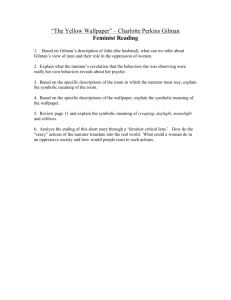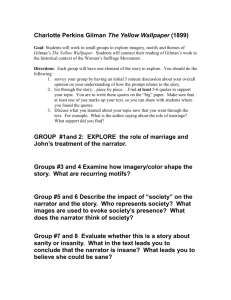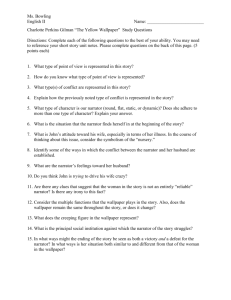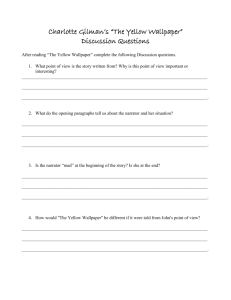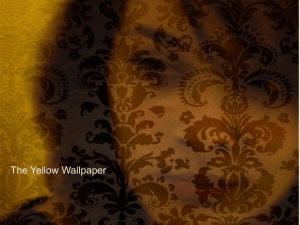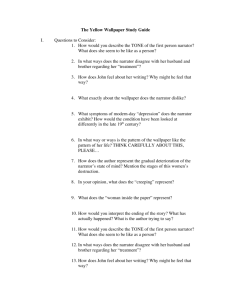The Yellow Wallpaper
advertisement
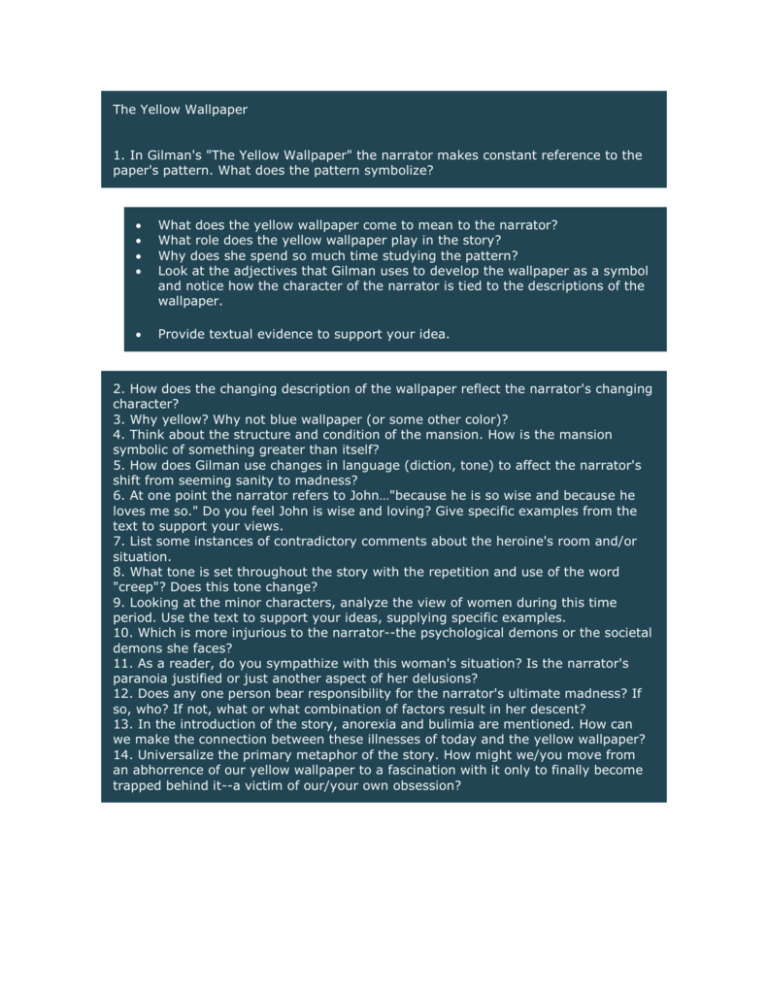
The Yellow Wallpaper 1. In Gilman's "The Yellow Wallpaper" the narrator makes constant reference to the paper's pattern. What does the pattern symbolize? What does the yellow wallpaper come to mean to the narrator? What role does the yellow wallpaper play in the story? Why does she spend so much time studying the pattern? Look at the adjectives that Gilman uses to develop the wallpaper as a symbol and notice how the character of the narrator is tied to the descriptions of the wallpaper. Provide textual evidence to support your idea. 2. How does the changing description of the wallpaper reflect the narrator's changing character? 3. Why yellow? Why not blue wallpaper (or some other color)? 4. Think about the structure and condition of the mansion. How is the mansion symbolic of something greater than itself? 5. How does Gilman use changes in language (diction, tone) to affect the narrator's shift from seeming sanity to madness? 6. At one point the narrator refers to John…"because he is so wise and because he loves me so." Do you feel John is wise and loving? Give specific examples from the text to support your views. 7. List some instances of contradictory comments about the heroine's room and/or situation. 8. What tone is set throughout the story with the repetition and use of the word "creep"? Does this tone change? 9. Looking at the minor characters, analyze the view of women during this time period. Use the text to support your ideas, supplying specific examples. 10. Which is more injurious to the narrator--the psychological demons or the societal demons she faces? 11. As a reader, do you sympathize with this woman's situation? Is the narrator's paranoia justified or just another aspect of her delusions? 12. Does any one person bear responsibility for the narrator's ultimate madness? If so, who? If not, what or what combination of factors result in her descent? 13. In the introduction of the story, anorexia and bulimia are mentioned. How can we make the connection between these illnesses of today and the yellow wallpaper? 14. Universalize the primary metaphor of the story. How might we/you move from an abhorrence of our yellow wallpaper to a fascination with it only to finally become trapped behind it--a victim of our/your own obsession? 2. How does the changing description of the wallpaper reflect the narrator's changing character? 3. Why yellow? Why not blue wallpaper (or some other color)? 4. Think about the structure and condition of the mansion. How is the mansion symbolic of something greater than itself? 5. How does Gilman use changes in language (diction, tone) to affect the narrator's shift from seeming sanity to madness? 6. At one point the narrator refers to John…"because he is so wise and because he loves me so." Do you feel John is wise and loving? Give specific examples from the text to support your views. 7. List some instances of contradictory comments about the heroine's room and/or situation. 8. What tone is set throughout the story with the repetition and use of the word "creep"? Does this tone change? 9. Looking at the minor characters, analyze the view of women during this time period. Use the text to support your ideas, supplying specific examples. 10. Which is more injurious to the narrator--the psychological demons or the societal demons she faces? 11. As a reader, do you sympathize with this woman's situation? Is the narrator's paranoia justified or just another aspect of her delusions? 12. Does any one person bear responsibility for the narrator's ultimate madness? If so, who? If not, what or what combination of factors result in her descent? 13. In the introduction of the story, anorexia and bulimia are mentioned. How can we make the connection between these illnesses of today and the yellow wallpaper? 14. Universalize the primary metaphor of the story. How might we/you move from an abhorrence of our yellow wallpaper to a fascination with it only to finally become trapped behind it--a victim of our/your own obsession? king at the minor characters, analyze the view of women during this time period. Use the text to support your ideas, supplying specific examples. 10. Which is more injurious to the narrator--the psychological demons or the societal demons she faces? 11. As a reader, do you sympathize with this woman's situation? Is the narrator's paranoia justified or just another aspect of her delusions? 12. Does any one person bear responsibility for the narrator's ultimate madness? If so, who? If not, what or what combination of factors result in her descent? 13. In the introduction of the story, anorexia and bulimia are mentioned. How can we make the connection between these illnesses of today and the yellow wallpaper? 14. Universalize the primary metaphor of the story. How might we/you move from an abhorrence of our yellow wallpaper to a fascination with it only to finally become trapped behind it--a victim of our/your own obsession?
